Foreword:
This is a theoretical preview from the perspective of a relatively objective fan of the club. I hope to return to the tactical outlook of Chelsea latterly, with more emphasis on how the theory worked out in practice, how Mourinho and his coaching staff have implemented the general strategic framework they have imposed on the players: ……..
Previewing Chelsea tactically is a hard task. This seems a strange remark, given Mourinho’s rather obvious tactical framework. Yet, what we see when we look at Chelsea is potential for huge tactical diversity. What I aim to do in this preview is to bring out the key themes that I feel will bring Chelsea success this season, namely an the creation of numerical overloads on the left hand side, and use of a rotational trio in midfield and the potential of a higher defensive line. But we must first look back to last season, and explicate why, despite in many senses being vintage Mourinho, he failed to bring his club a trophy, despite being in the optimal position to do so on many occasions:
Part 1: Season 13/14; Snatching defeat from the jaws of victory:
Season 13/14 embodied a season unlike any Jose Mourinho season. He won no trophies. But many things remained the same. First among these was his results against big teams, dropping only 2 points. What was so impressive about these results was as much to do with the variety of methods used to gain them. Against Arsenal and Liverpool at Stamford Bridge, intensive pressing and quick attacks started from high up the pitch was the chosen method, Oscar being particularly impressive in how studiously he pressed, while creating numerical overloads to the right hand side. Against City Home and Away, a deep defensive line was used, with attacks focused down the flanks, often with more fluidity than was often attributed to the club at the time. Hazard was immensely impressive in the latter match, drifting laterally from left to right , rarely being dispossessed, drawing men away from the likes of Ramires, Willian and Eto’o to find space inside the City area. The second City match was also characterized by lightening quick counter-attacks from interceptions very deep in the Chelsea half. Mourinho’s strategy could hardly be called cautious, so much as highly based on transitional attack. And against Arsenal at Home and Liverpool Away, it was described as parking the bus, unfairly so in the former case. Tactically it was defined by having a deep defensive line, a highly narrow set of midfielders, one of whom was allowed to break occasionally from the teams rigid structure. So, we see 16 points from 18, gained in three distinct ways; intense pressing and vertical passing, minimal pressing with counter-attacking based on dribbling from wide areas, highly rigid defensive play, with space being left as teams become more desperate to break your team down, with substitutions being made to capitalize on the counter attack. This was the positive side of Chelsea’s 13/14 season, the negatives were rather different in nature.
What Mourinho needed to reverse were results against teams, particularly away from home, who were in the bottom half, and willing to sit ultra-deep, while continually countering in wide areas. Chelsea’s problem here was three fold, a total lack of ambition in the passing from midfield a set of strikers who thrive upon space behind defenders, while the one player capable of successfully attacking such a defense, Hazard, failed to track back sufficiently diligently to prevent attacks down the Chelsea left (leading to Juanfran’s two assists at Stamford Bridge).
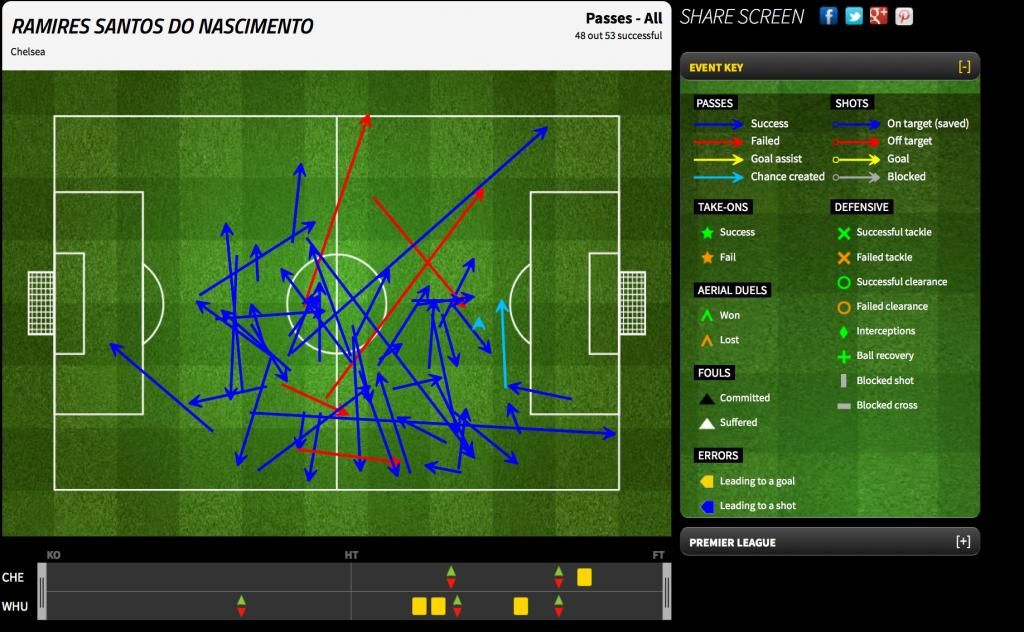
Ramires demonstrating Chelsea’s unambitious passing from deep.
This led to dropped points against the likes of West Brom, Sunderland, Aston Villa, Norwich, West Ham and Crystal Palace, ultimately costing Chelsea the league title. The problem was arguably more pronounced against Atletico Madrid, whom they managed to take the lead against, yet lost 3-1, at no stage in the tie finding a way of attacking an ultra-well organized defense without compromising on defensive shape. As would be expected, Hazard’s defensive negligence cost Chelsea two goals in the tie, for failing to track Juanfran.
Season 2014/15:
I now talk about ways in which Mourinho seems to have sought to solve the problems. But since this is a tactical preview, I first begin by defining what Mourinho has as an objective, which should allow more clarity in how he will attempt to resolve the problem, since any problem has multiple ways of being approached, it is your holistic objective which determintes how any problem should be approached, and hopefully solved.
The objective:
Mourinho is commonly seemed to be defined by defensiveness. As I will say in later articles, this is both untrue and self manufactured by Mourinho. Instead it is pragmatism, and what he is doing in his long term vision at Chelsea is a highly pragmatic idea for his project at Chelsea, the first team he has planned for the long term, a team in which he has imposed his footballing ideology on to the largest extent of any of his previous teams.
‘The ideal is to play always in a high block, is to recover the ball very, very fast, is to have the ball and to build well, to have always a control of the game, to be proactive and not reactive . . . but the point is to have the ball possession but to use it in the proper way’
Mourinho; Sunday Night Football: 21/9/13; Post match interview vs Fulham H
In simplistic terms, this means a high defensive line, with pressing starting high up the pitch, to regain the ball, and exploit the defence when it is reorganising after losing the ball. The possession that results from winning the ball is not to be intrinsically cherished, but used to score as many goals as is possible.
The Solution:
The solution consists in new signings. But the new signings themselves change little, it is how they are being set up to interact with the existing players in the squad which forms the solution.
- Diego Costa, and the left hand side overload.
Diego Costa is a very strange player. I confess to having not seen him too much, but when you watch him, it is a remarkable experience. There is a ruggedness to his game, a rawness that is surprising for a top level footballer. He relies on winning battles, he has an obvious determination to be better than his marker through sheer willpower. Yet he has an surprising turn of pace, a remarkable clinicalness in front of goal, movement that belies his image both on and off the ball. But he retains the intenseness in everything he does, intensely concentrated, very hard working when he presses the ball. He also holds the key to Mourinho tactically.
This is due to the liberating effect he will have on Eden Hazard. Contrary to popular opinion, Hazard actually underperformed last year. This may seem an odd statement, he was statistically effective, scored a fair few goals, was voted Chelsea player of the year, and widely seen to have carried the team. Yet, for the first 10 games he was average, Oscar was the star. Then Hazard came into his own, but got injured, and never really recovered. One reason for his (relative) ineffectiveness was a deprivation of space. Teams regularly put 3 men around his preferred space to the outer left of the D, from where he can dribble quickly towards goal, always ready to thread a pass through, or work a shooting opportunity. Hazard did well to escape this threat, drifting laterally, to especially good effect against City away, forcing men to come across and challenge him (he beat them) while also exposing the opposing team positionally. This however, blunts him, he is not natural goalscorer, and he gets forced sufficiently deep that a killer pass is not on. He is resorted to ambitious dribbles (which are more useful defensively than offensively), or conservative tempo maintaining passes. While opponents did this to Hazard, it was his own team who really inflicted the damage. Azpilicueta came inside, rather than outside Hazard, forcing Hazard to take the ball on the outside, never his strongest suit, especially against so many men, and with no-one attacking the box. As importantly, Oscar’s preferred zone is to the right of centre, Hazard’s to the left. This damages Hazard, who likes to play 1-2’s with a player moving across to him, as he cuts inside. (see his goal vs West Ham, from the right, or vs Sunderland, with Lampard from the left). Oscar also likes to drop deep to receive the ball, though often out of necessity, since the quality of the ball into attacking phases was so poor. Again, this further isolates Hazard, and allows triple marking to take place easily, teams who sit deep have no need to move up to press Oscar, and instead guard the space Hazard wants to move into. There is no threat from anywhere else, Ramires is hardly the person you need to close down, Lampard was (surprisingly) positionally disciplined, and lacks the ability to dictate tempo, or even hit accurate long passes. Nor would Torres run the left hand channel distracting opponents from Hazard, he like Oscar prefers the right-hand channel. This is not necessarily a reason for failure, a player can score in systems where most of the play takes place away from him, David Villa did exactly this in the 2010 world cup. But when the player you are isolating is a)not an amazingly effective finisher, and b) your main creative outlet, the situation is far worse.
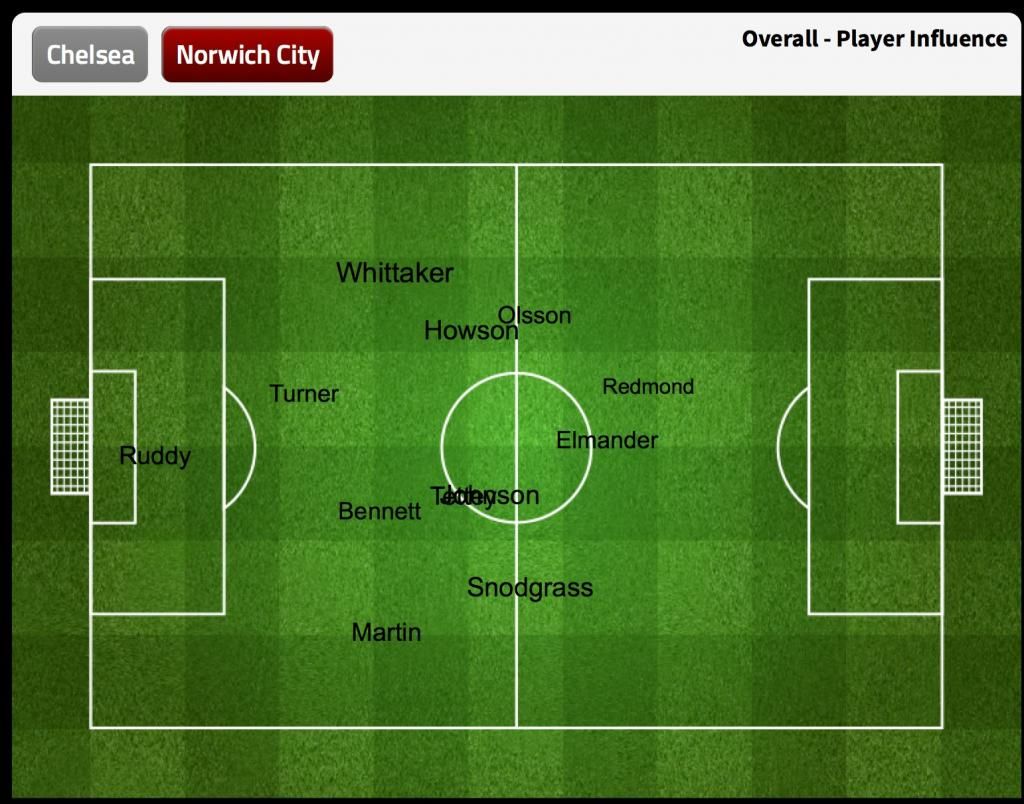
Norwich’s right side, 4 players around Hazard’s zone.
However, the situation has been solved, mainly by Costa. His favourite movement is to move in behind the space between Left and Left Centre back. Should the left back narrow up, Costa can run outside him, and retain possession with either Hazard or Filipe. This should give Hazard more opportunities to come infield. And thus more goalscoring potential. If the defense remain in a less compact state, Costa can receive through passes for 1 vs 1’s, something Costa thrives at. This ignores the vastly superior link-up play Costa offers, dropping deep at the right times to interact with attacking players in fast moves. Exactly what Hazard requires to thrive. And this is nearly always to the left hand side. Filipe is a player who can certainly overlap, create chances, while not compromising defensive structure. Moreover, he may absolve Hazard of the need to transition back as quickly, since he presses better than either Cole or Azpilicueta. As a byproduct, it will also mean that Hazard gets more turnovers within his own half, giving Hazard more opportunity to drive at depleted defenses. These points are all made generally, but apply especially well for teams of an ultra defensive mindset. To blockade Hazard now leaves the team open to having multiple players being beaten, with more players now in dangerous areas around him. Even if they insist on playing this way, there are now more players who Hazard can play 1-2’s with, or make distractionary movement for Hazard to exploit. Additionally, with Filipe now offering natural width, to play as narrowly as teams tended to is dangerous, Costa is no Drogba, but he can attack near post crosses effectively. This all fails to mention the possibility of quick switches of play to the right hand side, where Cesc Fabregas lurks, waiting to play a killer pass. To give him more space is suicidal. This all ignores the obvious improvement caused by the sheer increase in quality that Costa offers over Ba, Eto’o and Torres.
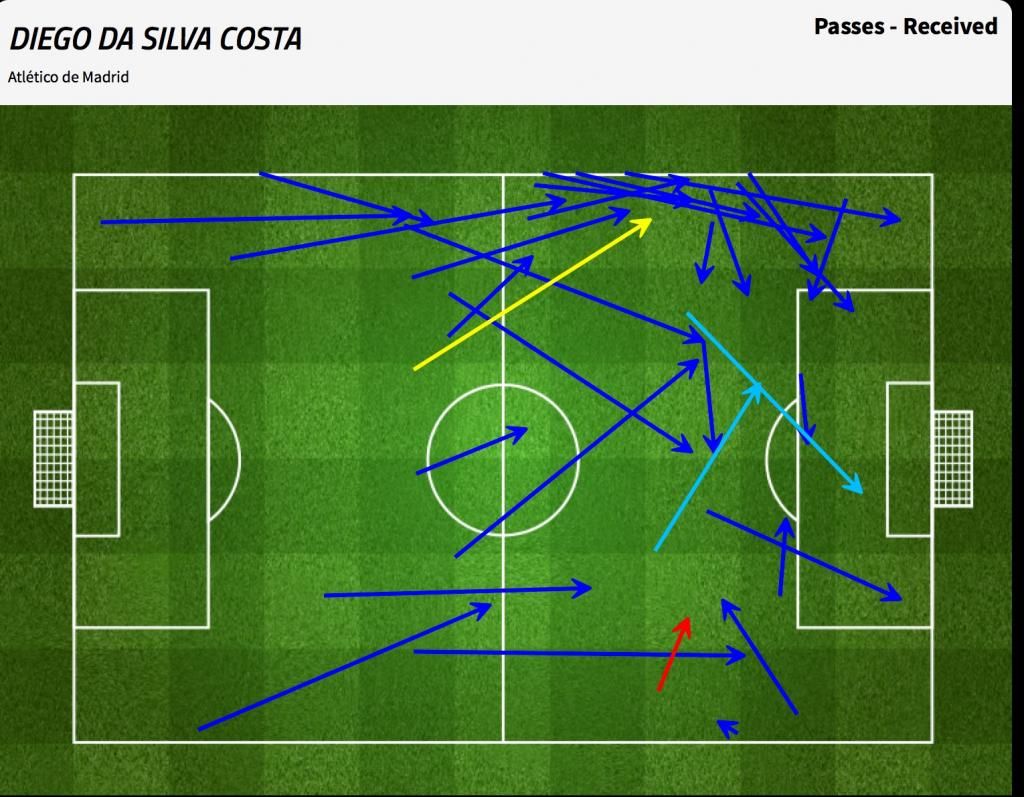
The passes that Diego Costa received against Valencia 13/14. It demonstrates a clear left-side bias. HIs shots also came from a left hand sided position.

Filipe Luis’s passing chalkboard. It shows a tendency to make short passes infield from wide areas, and to hit near post crosses from advanced areas. If this trend continues, it indicates more natural width, conducive to giving Hazard more space.
- Cesc Fabregas, Oscar and the flexible double pivot.
Cesc Fabregas immediately struck most people as an odd summer signing. A player who had spats with Mourinho, a spiritual successor (according to many mistaken individuals) to Xavi Hernandez. It was to me, immediately apparent what his role was. As has been mentioned, our major problem against ultra-conservative teams had much to do with a poor ball into the band of 3 behind Torres. Fabregas offers this in abundance. But it is more complex than this, since it is theoretically plausible for a team to man mark him, and continually press him. The solution has to do with the interaction between Matic, Oscar and Fabregas.
Oscar is a nominal number 10, but is a fundamentally defensive player. His role is to set the tempo of pressing. Last season he also played a pivotal role in ball regulation, dropping incredibly deep, often behind the double pivot, before moving forward into half-spaces to the right of centre. Matic was Chelsea’s usual holding midfield player, though this terminology denies the full extent of his role, he is far more box to box, winning the ball, advancing with it, and distributing it safely forwards. Fabregas, as we have just discussed is capable of dictating the entire tempo of a match, but can also slip a killer ball through. What Mourinho has done, and aims to do, is create a rotational midfield, possibly to compensate for the lack of vertical runs inherent within a 4231. When Oscar comes short to receive, Fabregas will push on, Matic will offer himself as a passing option. Sometimes, one of the midfielders advance as a 3rd man runner, knowing that Oscar will hold position if the move breaks down. This negates one of the more pressing criticisms of Chelsea’s move for Fabregas, his weak defensive transitions. If his movement forward is compensated by an Oscar movement backwards, in addition to Willian narrowing and tracking any full back runs, Fabregas is a minimal liability. Of course, in bigger games, the smallest of weaknesses can be exploited, so a 4-3-3, or more cautious 4-2-3-1 may be played.
But a rotational midfield, which offers makes Chelsea more unpredictable, is not the only thing that Fabregas offers. Against low blocks, his contribution will be two fold. Firstly, his own passing range, and agility is such that he can directly open up a defense. Here, he serves the role of a Luka Modric, moving forward, always dictating the tempo, but also capable of escaping a heavy press through a little dribble to allow an attack to begin. But as importantly, is the liberating role he will give to Matic. At Benfica, he made his name at the base of a diamond midfield, being positionally disciplined, but also hitting moderate length passes out wide (especially to the left full back). At Chelsea, he could be pressed more easily, Ramires left free to make unambitious passes. With Fabregas, this is not the case. Most opponents will want to occupy Fabregas, perhaps leaving Matic free. This allows him to have acres of space, and plenty of time on the ball to play measured balls into dangerous areas. If opponents close down both, then they run the risk of an easy ball into Oscar or Hazard, and compromising their defensive structure (for all but the best and most systemised pressing structures). Or, you leave both free, and concede the game, and hope that Fabregas fails to play a killer pass for a match.
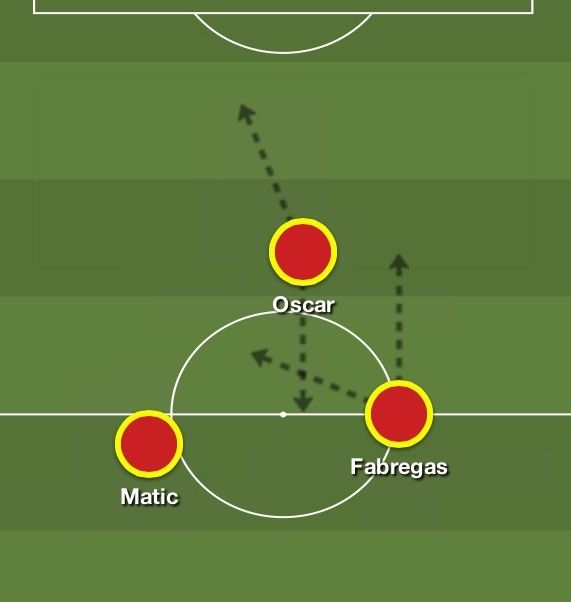
The rotational midfield trio. Oscar drifts more than the diagram suggests, off the ball it is far more solid (Oscar is always the highest in the defensive phase, offensive phase he comes deeper than Fabregas with regularity).
3. Kurt Zouma, John Terry and a transition to a Mourinho defense.
When Kurt Zouma came to the club, I was very happy. Here was a young Centre-Back, very raw and but one who had been playing regularly for a Ligue 1 team. When someone that young gets so many games, it is presumably for his athleticism, only the greatest technical players stand out so early (one reason for Rooney’s early emergence was his sheer physicality, which was in stark contradiction with his age). Having seen him play during pre-season, this has only confirmed my initial thoughts. He is physically massive, yet quick over ground. He will win the majority of headers, aggressively tackle (sometimes cynically to prevent counters) he is capable of covering ground. He is wreckless, raw, technically deficient in touch and sustained dribbling. David Luiz, in the latter two senses, is everything that Zouma isn’t. But Mourinho’s purpose for Zouma is key, in the medium term, to creating a defence that is solid, high pressing, yet can accommodate John Terry. Long term, he may well be part of the replacement for him.
A fundamental deficiency in Gary Cahill’s game is his tendency to back off (see his awful attempt to prevent Manu Adebayor from scoring under Benitez). He often saves the day from last ditch clearances, admirable, except for the fact that Cahill’s error in anticipating danger caused the problem that he has to rescue. He is, as Michael Cox recognized when he was first purchased, a back-foot defender, a cover defender, great at seeing danger ahead of him, pushing up to catch opponents offside. The problem is, that this relies on a quick, aggressive partner to thwart attacks, with yourself taking good covering positions, and stepping up when necessary. This caused two problems initially. a) Chelsea’s club captain happened to be good as exactly this cover role, and mediocre stepping up and being aggressive due to his lack of pace, b) David Luiz fulfilled all of the former functions, but lacked consistency,. There was a 3rd problem, Cahill wasn’t very good at the role. When combined (as he regularly was) with Luiz, Luiz stepped up, Cahill dropped back, and there was a resulting ocean of space, particularly with full backs who were particularly energetic going forward. Cavani, Rooney and co exploited this to the full in games against Chelsea. When deep defence was required, this was ok, Cahill and Luiz both have qualities in last ditch defending, they are brave, positionally decent for blocking, fairly good at marking of players, and were incredibly well protected. But when asked to play proactively, the same old issues surfaced. This season, Cahill and Terry, the preferred partnership, universally impressed and Cahill in particular improved, partially because of his partners widely acknowledged organizational capacity. This improvement lasted even when playing a D-line that was not deep, he stopped backing off so regularly. But this was partially because of Terry’s instruction, as well as coaching, presumably.
What Chelsea have in Zouma is someone who naturally tends towards the game that we are coaching Cahill into, only younger, physically developed, with room to learn the game tactically perfectly, and who is apt enough at the more basic defensive arts that he can play deep. He can become the Terry of early years, proactively snuffing out attacks, with a more reactionary defender behind him. This season, he will be comparatively insignificant, 3rd choice CB at best. But in the future he can both complement and replace Terry.
4. Return of the King; Didier Drogba and Chelsea’s plan B:
The man who brought Chelsea the Champions League trophy is back. This time Drogba will play an auxiliary, but no less important role. Previously, his main asset was his sheer physicality, being quick enough to sprint behind opposing defences, yet strong enough to win aimless lumps up to him. His technical skills, though deficient in some key areas (dribbling, his first touch) developed to be sufficiently good to bring midfield runners into play. His possession of a fierce strike from distance helped to unlock low block defences, as did his quite superb ability to head the ball (people always talk about that goal in Munich, I think of a very different goal in Munich). Most of these things have been diminished, certainly his physical skills. But, with rest, he can perform one vital function for Chelsea, he can act as a defensive target man. Before I explain how, we should first define the position. A target man, in common football parlance, is a striker designed to be the focal point of attacks, often directed to his head. My use of the word defensive is merely a reference to how I suspect he will be used. He will come on with 20 minutes to go, against teams who may be a counter-attacking threat, to a) defend set pieces) but more importantly b)win balls in the air that are put up to him, and begin to attack from here. This is especially useful when considering the increasing emphasis on pressing in football, you cannot press a ball in the air, and when you have someone as effective as Drogba receiving it, a wasted ball possession is far less likely. So against teams like Everton, Tottenham (assuming a Pochettino pressing spree), Southampton (presuming the press continues), he is a useful weapon for initiating attacks against very heavy pressing that Chelsea will struggle to pass around. Even a footballing purist such as Guardiola did this against Dortmund. A pragmatist such as Mourinho will surely have thought of this possible useage of Drogba before signing him. In addition, in games in which Chelsea fall behind (and need to win) his still formidible physical strength could quite easily be used in a 352/343 hybrid system, something Mourinho utilised on various occasions when chasing games last season (and at Real Madrid).
5.
So, how will they line up:
From this, we can now create some hypothetical formations and line-ups.
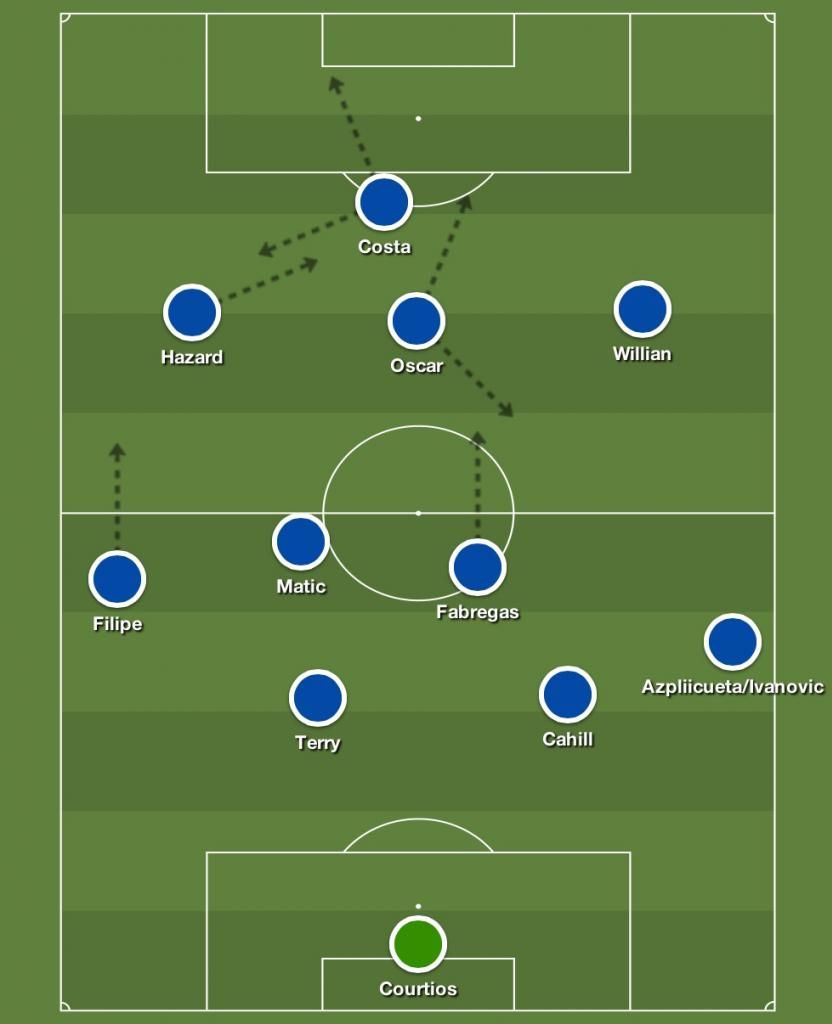
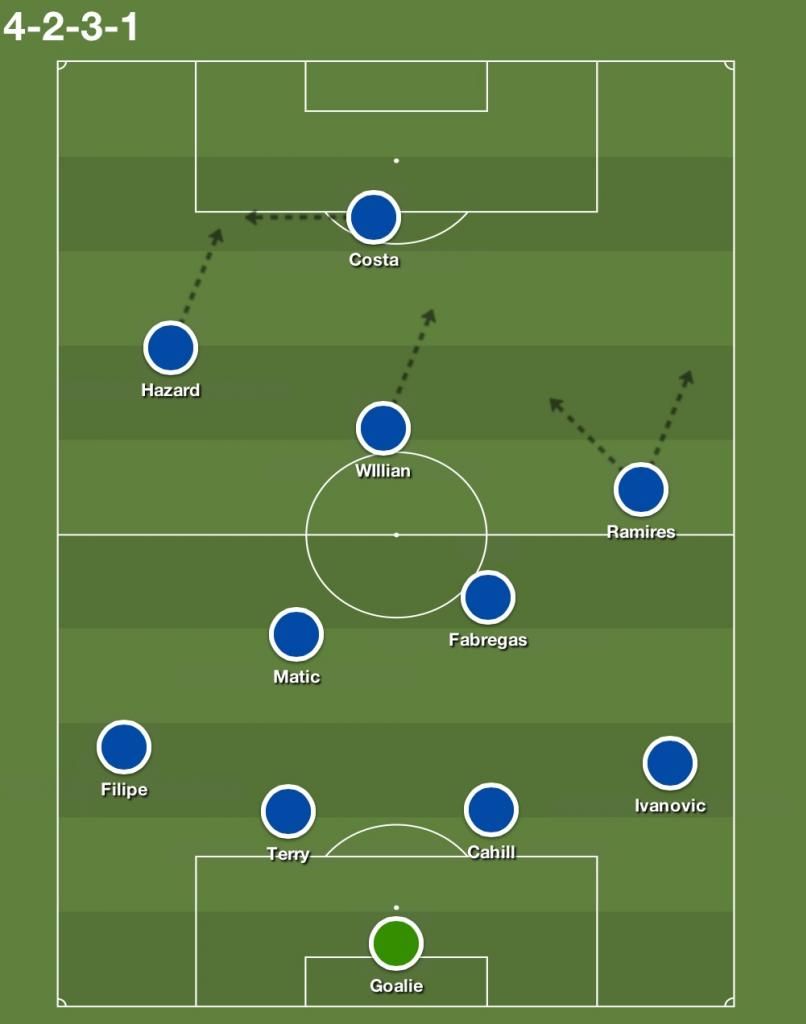
A slightly different system, with at least one more narrow midfielder. Less fluidity, and more counter-attacking (hence Willian’s inclusion, a more direct player who enjoys running at players).
3.
A 433 for Europe:
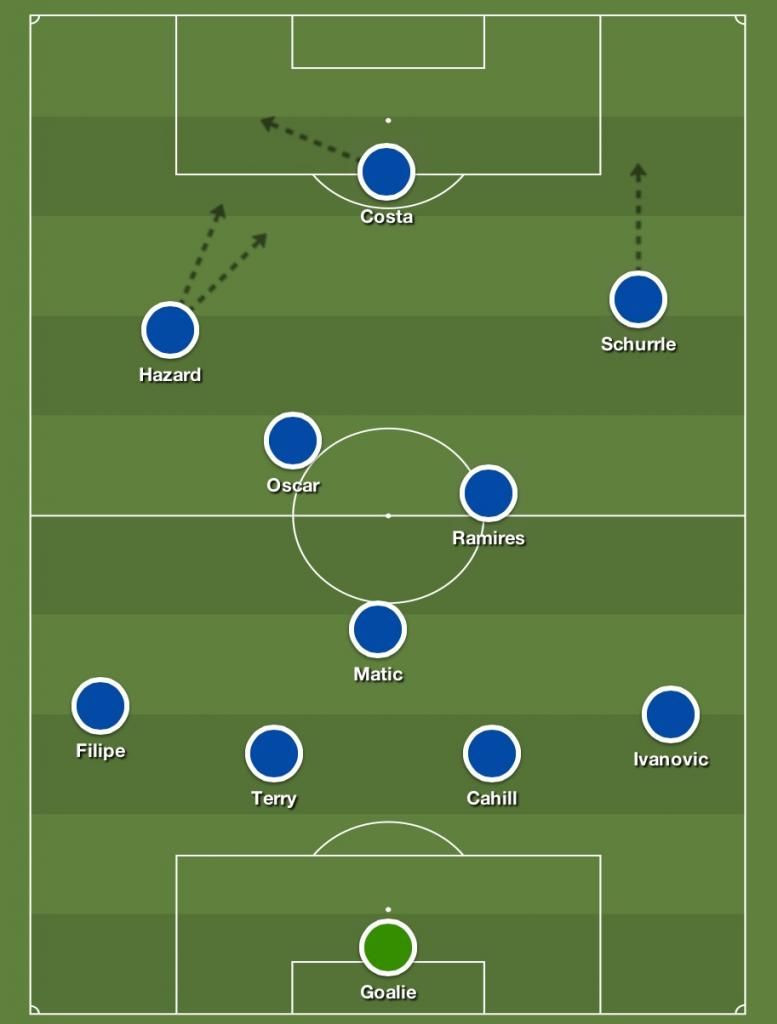
Matic could feasibly move forward to replace Ramires (who could in turn replace Schurrle) opening a space for Mikel to come in with an ultra-defensive version.
Midfield superiority is often the way to win in Europe. This is a highly counter-attacking formation, designed to press (but with more solidity), offer width without compromising team shape, and offer some more typical English physicality that defines Mourinho teams, especially against teams less susceptible to physical, direct play.
Conclusion:
Chelsea have by far the most varied attacking weapons in the league, many of whom I have not talked of directly. They have a manager capable of organising a highly organised defensive unit, a fluid midfield trio capable of combining verticality, control and organisation. An offensive line that now effectively combines, rather than restricts, its’ most important offensive weapon. They perhaps lack some of the typical Mourinho physicality, but this team make up for it in variety, astuteness, technical and tactical intelligence while not lacking any of the mental or physical endurance. They have also retained, in players like Mikel, Ramires, Willian, Schurrle, players who suit a particular tactical framework, while not being out of place in the holistic structure. These players are especially useful in big games when the objective is attacking space in behind defenders from deep positions. All this would make it a surprise if Chelsea failed to make the top 2, a moderate surprise if they fail to win the league, judging by Mourinho’s track record of success.
OW, 21/8/14
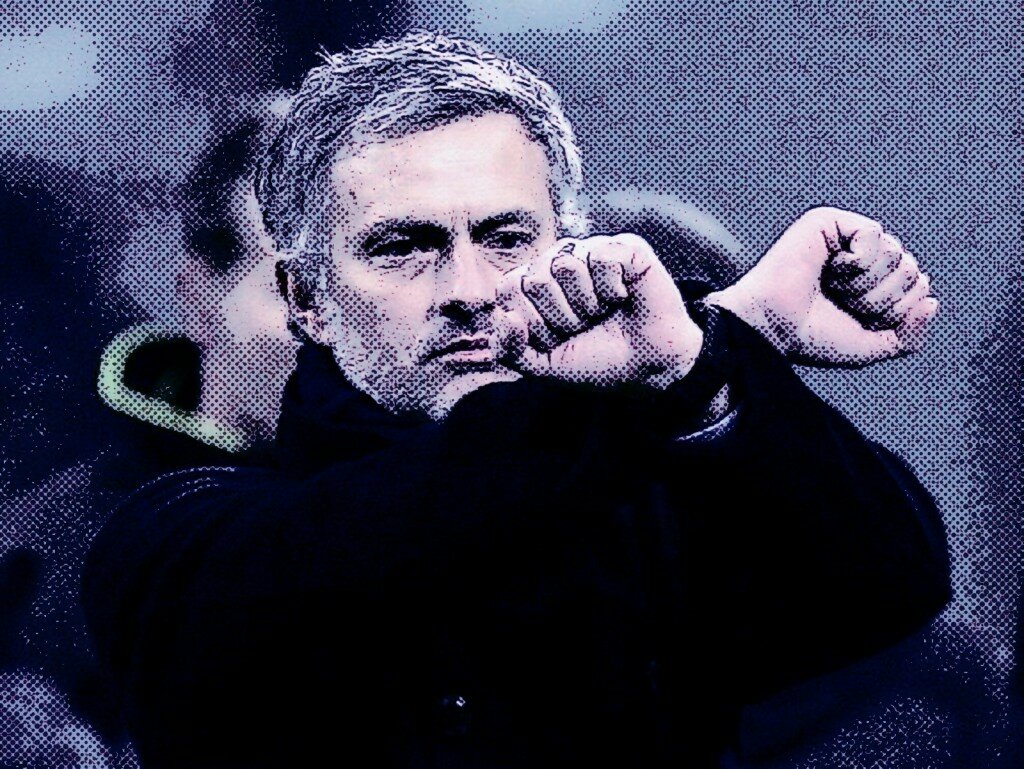
Comments 10
Great article.
One question, you say “However, the situation has been solved, mainly by Costa. His favourite movement is to move in behind the space between Left and Left Centre back.” Then you show the heat map of him playing against Valencia getting in between the right-back and right centre-back (where he also wrecked havoc in the first 20 minutes of Spain v. The Netherlands) . My casual observations as an Atlético fan tells me the same thing, although I also vividly remember some rampaging runs down the right. In the end, I tend to think Diego Costa goes wherever his gut tells him to.
Or, to paraphrase the Dr.Ian Malcom character in Jurassic Park:
“The kind of control you’re attempting simply is… it’s not possible. If there is one thing watching Atlético has taught us it’s that Costa will not be contained. Costa breaks free, expands to new territories and crashes through barriers, painfully, maybe even dangerously, but, uh… well, there it is.”
Author
Thanks for the comment Wouter, insightful and humorous as ever. No doubt that Costa likes to roam and destroy anything in his path, but it does look like Mourinho will try to get him to play left side. As much from the Inter team of 09/10, when Milito did much the same thing. I did actually come very, very close to saying that he is basically a more physical, mobile and aggressive Milito equivalent, but I thought better of it. Will be interesting to see what Fabregas does when he is (inevitably) used as a 10, he likes to play left half space, which may tilt the team too far to the left.
Once again, thanks for the comment.
Wow. Great read. Was absolutely in another Zone while reading. Was like I was in a dressing room. A classroom. Taking a lesson n all.
Great Article yo.
Author
Thanks, Seun. If there is any more detailed feedback, please offer it here, I want to provoke my readers, this is the websites only goal. Please check out the other articles, they all have deliberately stimulating content.
Thanks again for reading.
Oliver
Absolutely fantastic, articulate piece. I read a lot of things football related, including tactical analysis and many can be incredibly generic. The icing on the cake would of been a more prominent feature of Andre Schurrle and the natural width & versatility he brings to Chelsea, but obviously I understand in the interests of brevity the decision to leave him out.
I think this Chelsea team has the potential to replicate the swashbuckling attack of 09/10 under Ancelotti with the stalwart defence of 04/05 (perhaps to a lesser degree)
Again, brilliant piece
Regards, from a fellow Chelsea fan
Author
Hi Rishi, thanks for the generous praise and insightful comment.
I agree on Schurrle, I omitted purely because of space, Willian’s counter-attacking Ozil-esque movements would also have been another topic I would have included, but there is, as you rightly remark, a balance between brevity, and detail (I aim to do a more practical piece on Chelsea’s tactics, as I mention). On Schurrle, it is interesting, he is very much a wide forward a la Duff (when he played in the left) with clever movements behind the full back (but on the left is arguably more effective, even though he is more predictable). Hazard is far more of a Joe Cole (and hopefully far better, if he learns to shoot far more efficiently). Will be a lot of wing-switching I suspect. With Willian, it will also be interesting, just because I suspect in games against City, he will be the difference maker.
I suspect we will be as offensively effective as times in 04/05 (the 4 4-0′s in a row!), but never quite as solid, the rotation will stop the same level of midfield solidity/the league has got better. Inter 09/10 may be the best comparison, great counter-attackers, capable at provoking the ball against weak opponents, pressing while also remaining compact into an almost half-press.
Thanks again, feel free to engage with the site more, it isn’t exclusively Chelsea, but we do provide content of this ilk, and other, more historical or philosophical pieces. I have one coming up on what defines Jose Mourinho, my co-author on the impact of the WC in Brazil+ a weekly podcast.
Best,
Oliver
This article was absolute rubbish, what a waste of my time
Author
Hi Israel,
Since this is a site that thrives on dialectic discussion, I would be very happy to listen to what makes this article terrible. As per our comment policy (see Contact, section 1), I have removed the swear word from your post. Though this is a rather boring and meaningless comment which I could have deleted, I would be interested on what aspects of the article make it bad, rather than specifying nothing in particular and implying a swear word.
Thanks for reading anyway,
Oliver
I like the article. Just one point to check on is that Hazard was subbed off in the 17th minute of that Atletico game with an injury if I remember correctly. So it seems unlikely that he his to blame for the two goals that happened after he was subbed off.
Author
Hi Andrew,
I think you are thinking of the PSG game, after which Schurrle came on and scored. Having checked the team sheets and Zonal Marking (http://www.zonalmarking.net/2014/05/02/chelsea-1-3-atletico-juanfran-skips-past-hazard-for-two-goals/), I believe I am correct.
Many thanks for the generous praise, as I have said repeatedly in the comments, prokoving thought and enjoyment for our readers is the only aim.
Best,
Oliver